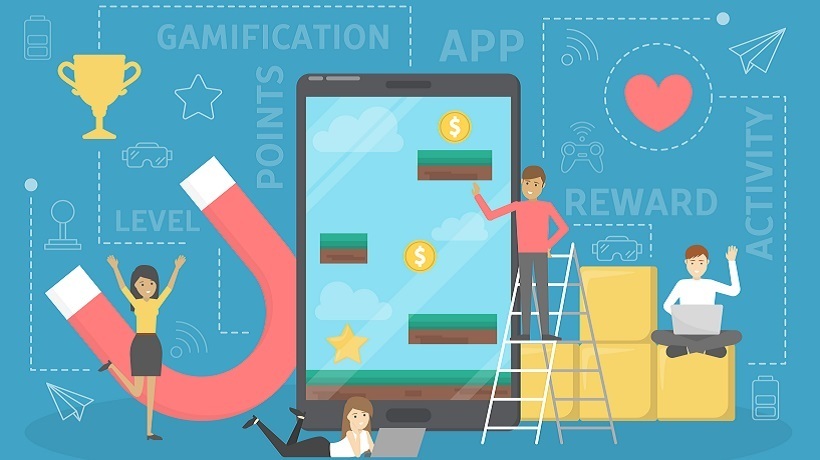How To Use Gamification In Education
Games get you going. They make you laugh and cheer when you win, and groan when you lose. They can be played one against the other, group against group, human against the computer, or all by yourself. In addition, they inspire competition and grab attention. Games are fun and who doesn’t want to have fun while learning? Although “gamification” is still a fairly new term, human resources departments and training programs are already touting the use of gaming strategies to make work and study more engaging, rewarding, and applicable. Educators shouldn’t be the last ones to employ these methods; a change will inevitably take place, and teachers and parents can either begin now to strategically prepare or stay behind. From Codecademy to Duolingo to Study Island, there’s a plethora of programs out there to emulate.
Gamification adds fun to the classroom by using what comes naturally to humans – social play. In this article, we discuss how gamification can improve learning, as well as 6 ways to gamify your classroom.
What Is Gamification?
Put simply, gamification is the use of gaming principles in the field of education in order to get students involved, engaged, and excited about learning. Gamification introduces concepts like badges, levels, achievements, and game points to the classroom. Students are rewarded with these concepts when they succeed, but are not penalized when they don’t. By introducing a system of rewards without harsh penalties, students are not afraid to step outside of their comfort zone and fail. By removing their fear of failure we subconsciously encourage them to learn.
How Can Gamification Affect Learning?
In the 90s, there was an educational program called “Fizz and Martina’s Math Adventures” shown in many elementary schools. The show followed Fizz (who resembles an alien) and Martina (an ant) through four engaging adventures. Students worked in collaborative groups to solve the problems posed throughout the show. Rather than just write down answers, students were forced to explain the reasoning behind their solutions. If they did well enough, teams could earn “award cards” with pictures of the characters on them. And let me tell you, students loved it. In fact, they loved it so much that you’d often hear students asking their teachers to stay in for recess so they could keep playing. That’s innovative education. Recently, there has been a surge in “gamifying” education to motivate learners to engage with the material. Is this a fad, or a natural evolution in educating the next generation of students?
“Fizz and Martina” came in a time before iPhones, iPads, and before the word “app” was a household term. Now, I look at my nieces—both under the age of six—and their ability to navigate any app with ease surprises me; they understand every button and function intuitively. That’s because quick-changing technology has been part of their lives since birth.
To educate this very different group of students entering high school, middle school, and even preschool, we need a new approach to the way we teach, train, and interact. Technology is the key, but this is not just about hardware and a blank screen. By using game mechanics, the educational practice can transition from a lecture to an interactive and engaging activity. Now, like any parent who watches his son or daughter drain away hours and hours behind the screen of a Nintendo DS, I’m sure you’re asking yourself, “More games?” Let me ease your doubts. Games are inherently social. They’re built on the social qualities of people. Sure, we can defend that books and lectures as learning tools, but it begs the question: is this the most effective way to engage students? If you target students’ natural tendencies—in other words, games—your chances of engagement will skyrocket.
6 Types Of Games In The Classroom
1. Online Educational Games
Giving students individual time to play educational games online either as part of a lesson or as a reward, is one of the easiest ways to integrate gamification into your classroom.
Here are some kid-safe sites that are free and don’t require an account to play their educational games:
- Room Recess
Developed by an elementary school teacher, Room Recess offers games that focus on math, language arts, spelling, reading, and basic problem solving with fun titles like “Zombie Paint” and “Tic Math Toe”. - Math Chimp
Aligned with Common Core Standards, this site offers over 200 free math games, printable worksheets, and videos for students from 1st to 8th grade. - Smart Kit
Great for all ages, this site offers fun games that focus on quick thinking, logic, math, brainteasers, physics, and more. - Other sites to check out include Duckie Deck, Fun brain, and Jefferson Lab.
2. Best Guess Rewards
This rewards-based competitive game will keep your students paying attention because at anytime you can offer a “Best Guess” question. With only a few materials, this game can easily become an everyday gamification integration. Materials: Computer paper, 60 numbered popsicle sticks, black marker, shoebox. Object: During a lesson, have students answer a question with their “Best Guess”. If they get the question correct, they write their name next to a number within one of the empty boxes on the “Best Guess” sheet. Play Best Guess once or twice a week and do the “Best Guess Rewards” by pulling one or more numbered popsicle sticks out of the shoebox. Whoever’s name is written next to that number gets the reward. Reward ideas can include an hour of computer time, outside play, the teacher’s assistant for a week, a pencil, a book, and other rewards both material and non-material.
3. Trivia and Riddles
No matter what your subject is, start your day off with an eye-opening piece of trivia or a riddle. Participation can be voluntary and rewards-based. Have students write their answer on a piece of paper with their name and hand it in or have them “shout out” their guesses. The reward can be their name in the best guess box or something else.
4. Youtopia
It’s worth your time to take a look at this classroom management site to help gamify your classroom. Youtopia uses activities, badges, points, and leadership boards to motivate and engage students. What makes this site so teacher-friendly, is its pre-built templates for customizable lessons. Just check a few boxes, plugin goals, curriculum, and activities, and your classroom is instantly gamified. The site is free for teachers with up to 50 students. After that, it’s $10 per month for 150 students. There is also a package for entire schools.
5. Board Games
Add board games to your teacher resource library or make your own. One of the best places to find ideas for making board games is on Pinterest.
6. Nintendo Wii
Use this popular gaming system in your classroom to actively engage and motivate your students. The Wii can be used as both an instructional tool and as a reward. Here are just a few ways you can use Nintendo Wii in the classroom.
- Geography, Weather and the News
Students can check and track weather around the world, read news from around the world, and access an interactive world map. - Surf the Internet
Involve the entire class, groups of 2 or more, or individual students with the Wii’s Internet Channel. Using the Wii’s controller, known as a Wiimote, students can browse the Internet and play games just like on a computer. - Make Slideshow Presentations
The Wii’s Photo Channel allows students to upload photos from an SD Card. Students can work on a variety of themed projects with this feature such as visually recording field trips and class events, documenting nature, and telling stories through pictures. - Play Games
The Wii has many games that your students can play in the classroom. From educational games to sports and fantasy, Wii is a successful way to gamify your classroom. With Wii, students will improve in many skill areas, including fine motor skills and social and technological skills. They can even learn to cook with the Wii.Manage your Game-Based Training with the best Gamification LMS!Find, choose and compare the top Learning Management Systems with Rich Gamification Functionality!
Challenges and Rewards
Our education system needs a wake-up call, and the gamification of course materials is just one aspect of this. The act of gaming is a natural part of our culture, and it will continue to be. We love the challenge, the rewards, and even the failures. We spend hours trying to beat a level, only to find a bigger challenge looming, just like in a classroom. Teachers who used "Fizz and Martina" back in the day were innovative risk-takers. And for them, the payoff was big: their students were almost always engaged in the materials, often begging to learn more. However, gamification can't be done in isolation. It requires integration with social elements in the right context, as well as some level of personalization. Namely, the tool must adapt to the strengths and weaknesses of each student. That way, every player will become a better and more engaged student.
By gamifying your classroom, you provide exciting incentives for learning while also promoting teamwork, healthy competition, and a safe and fun classroom culture. Include just a few of the above suggestions for gamifying your classroom and you’ll see both learning and classroom management improve.
About The Author
Ujjwal Gupta is the co-founder of BenchPrep, a cross-device learning platform that allows students to buy educational and test prep content from leading publishers and study across all devices. It allows students to take practice tests and get real-time scores. BenchPrep is backed by NEA, Revolution Ventures, and Lightbank, with more than 200,000 students using the platform.









